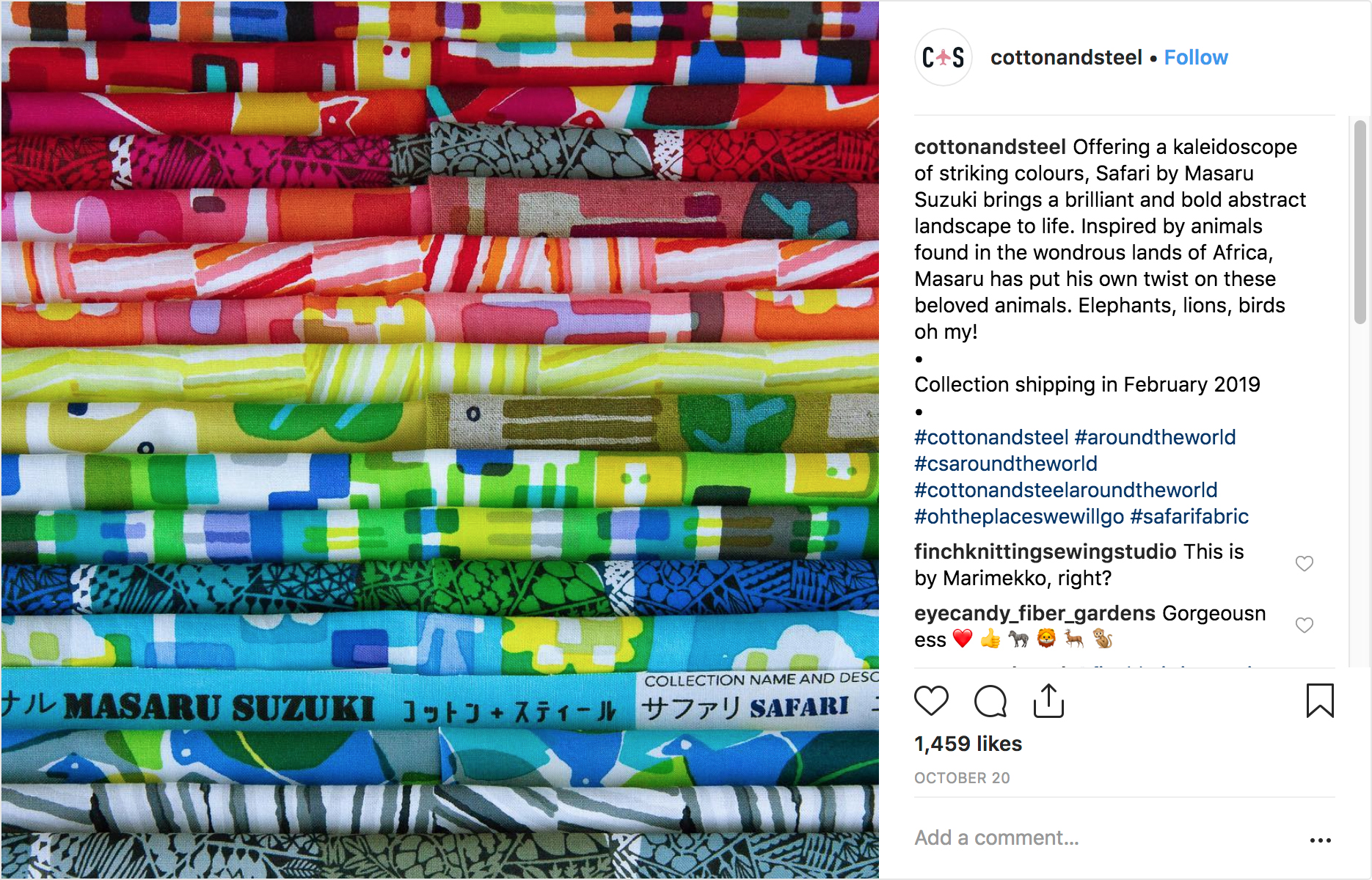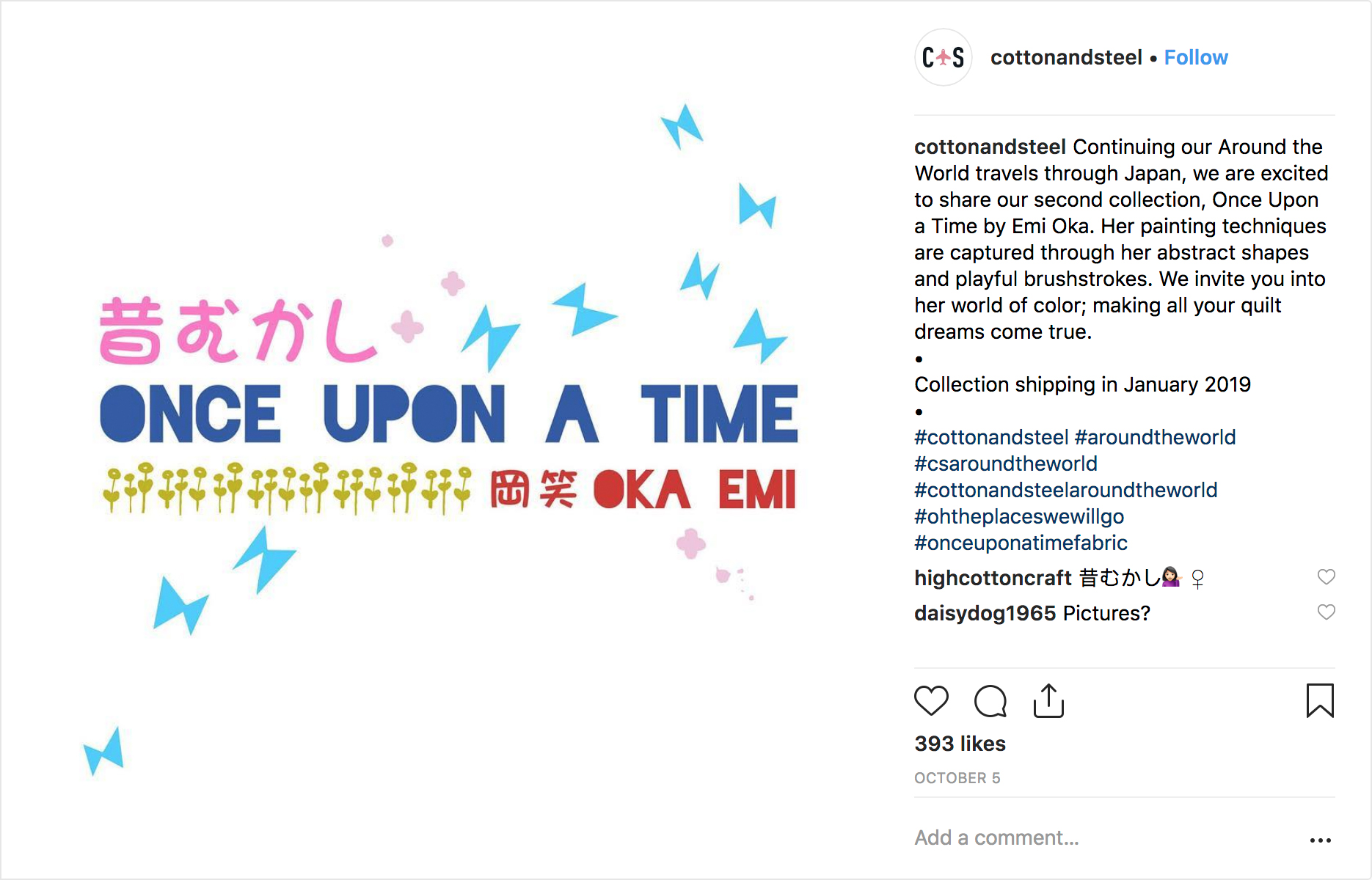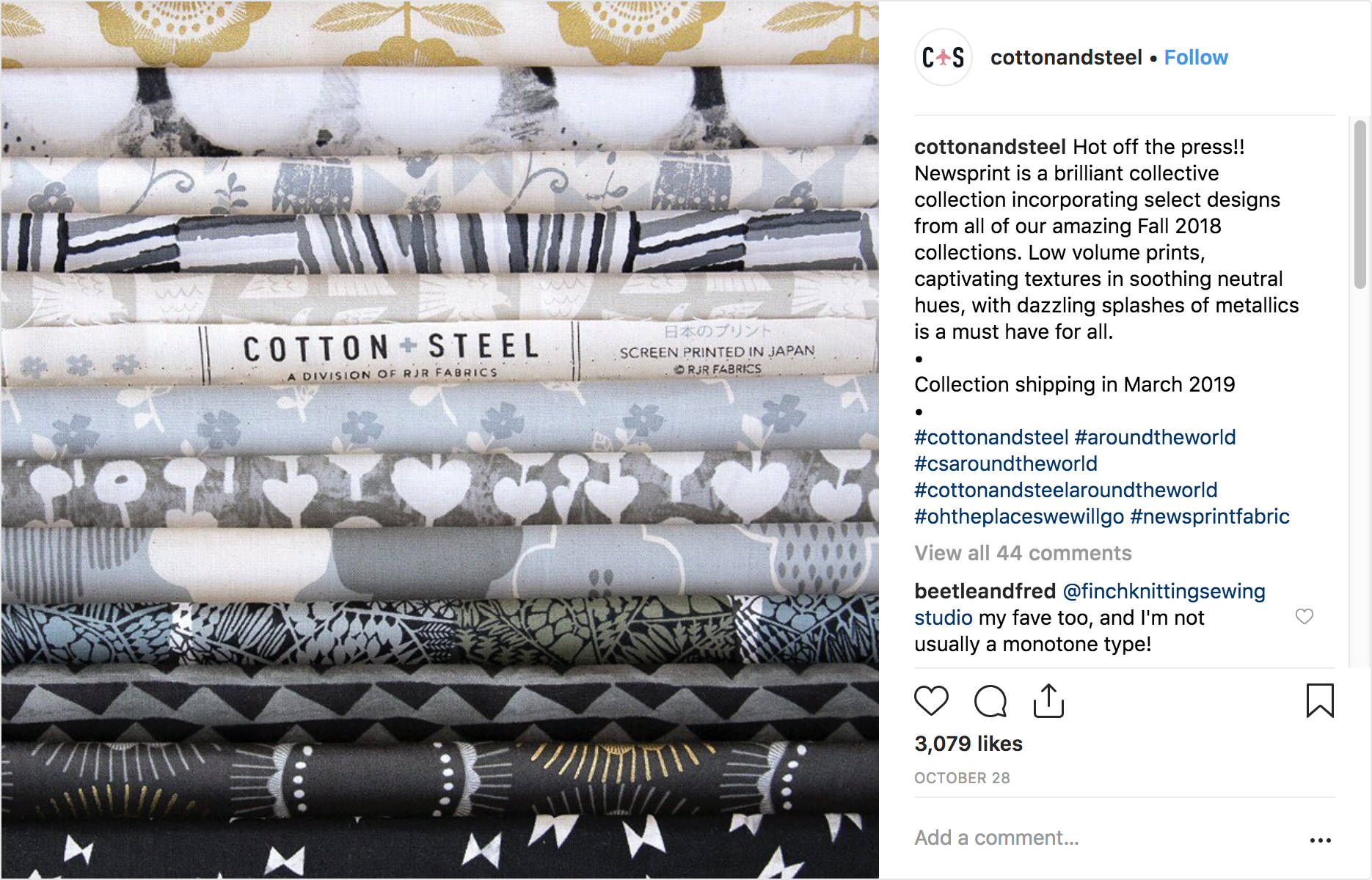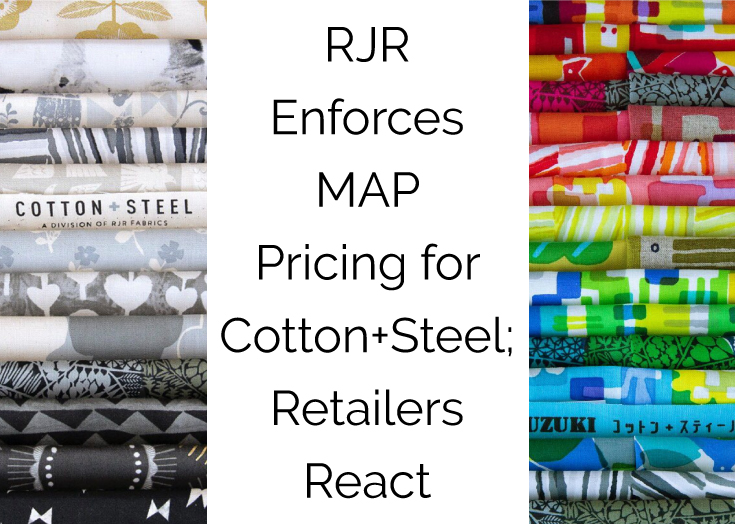On Friday, November 16, fabric company RJR sent an email to retailers notifying them of a minimum advertised pricing (MAP) policy that will go into effect for Cotton+Steel on December 1, 2018. Minimum Advertised Pricing (MAP) is a policy in which a manufacturer limits the ability of retailers to advertise prices below a certain level.
“Adopting MAP policies will enable our authorized partners to invest their time, energy and resources in selling and profitably marketing C+S products,” the email stated. “Equally important, the established criteria set forth in the C+S Brand Sales Policy will support our efforts to maintain the C+S premium brand image,” the email went on to say. RJR did not respond to my requests for comment for this story.

What is MAP?
MAP pricing only applies to the advertised price of a product, not to its actual price. Retailers are still able to sell those products at any price they choose, as long as it’s not advertised anywhere. For brick-and-mortar retailers, this means the in-store price can be lower than the MAP price. Things get trickier for online retailers, however. US Circuit Courts and FTC rulings have said that while listings are advertorial, checkout pages are transactional and can display the actual price of the product. Once a consumer adds the product to their cart, the price drop can be revealed as long as the MAP price was shown on the listing page.
MAP pricing is not to be confused with manufacturer’s suggested retail price (MSRP) which is a price the manufacturer suggests retail partners use when selling their products. Cloud9 Fabrics has always had a MSRP for the first 60 days after a collection is released, after which shops can discount the fabric however they’d like. “They need to turn merchandise (just as we do), and we cannot force them to hold this price for an eternity,” says co-founder Gina Pantastico.
RJR’s MAP policy
RJR’s MAP policy for Cotton+Steel is much more rigorous than that. Retailers are required to sign a brand sales agreement. Part of this agreement states, “Cotton+Steel resellers that discover a violation by another Cotton+Steel reseller are encouraged to report to Cotton+Steel Fabrics.” Violators risk having their purchasing rights revoked for periods of 30-90 days. A FAQ document explains that the company will be contracting with “an outside enforcement agency that will monitor online advertised pricing.”

The new online sales application includes other measures that seem designed to eliminate small, online retailers from ordering Cotton+Steel fabrics. RJR has raised its minimum annual order of Cotton+Steel from a $1,500 initial order with no annual minimum reorder to a $5,000 annual minimum reorder. Additionally, ecommerce sites must have a landing page that exclusively lists Cotton+Steel products and must display those products “in a manner that is consistent with the Cotton+Steel brand image as determined by C+S in its sole discretion.”
One small, online retailer I spoke with said MAP pricing made selling Cotton+Steel fabric impossible for her. “My annual spend is only 10k with them and I’m done. There’s no way I could adhere to these guidelines,” she says. “The only way I could do it without drastically increasing my inventory would be to either sell by the pound to not violate the per yard prices, or partner up with promos like, ‘buy 1 yard of Cotton+Steel, get 1 yard of Robert Kaufman Kona for free’ or some weird combo like that.”
And some bolts just don’t sell until they are clearance. I have lines I thought would do well that just sit on the shelf. I can’t imagine not being able to run a sale. I will miss carrying Rifle Paper fabrics, but with the move of the original designers to Ruby Star Society at Moda I will just move my business there. I already have a Moda account and they are extremely easy to work with,” she said.
MAP protects brick-and-mortar retailers
Ricky Brooks has had a MAP pricing policy in place since he founded RNK Distributing in 2004. “We’re seeing quilting retailers under attack by online sellers,” Brooks says. “But online sellers are obviously here to stay. I started RNK with a MAP policy because I promised my retailers that they would never have to be embarrassed or ashamed of the price of their products.”
Brooks says MAP pricing has hampered some online retailers from carrying RNK’s products. “They’ll have it, but it won’t be their best sellers. Their best sellers will be products with lower prices.” But RNK has a different focus. “We are dependent on the people who can show the quality of the product, who can demonstrate it and educate consumers about it. We’re catering to those stores. So yes, it can impede your business with online retailers, but the more it does, the more it builds your business with the brick-and-mortars.” Even so, RNK’s third-largest retailer is an online-only store that abides by the MAP pricing policy.

For Stephanie Soebbing, MAP pricing provides a welcome relief to the constant race to the bottom on price. Soebbing started her fabric store, Quilt Addicts Anonymous, online and opened a brick-and-mortar in Rock Island, Illinois a few years later.
“For the first year I struggled with how to compete on price before finally realizing I never could and needed to deliver value in other ways, like free video tutorials, subscription clubs, and creating fun projects others would want to do,” she says.
“We’ve seen large online retailers offer incredibly popular pre-cuts to the consumer for less money than we paid the manufacturer to buy the bundle less than a week after the collection shipped. That just makes the big guys richer and puts the small guys out of business. And we need the small guys, too. Even Jenny Doan can’t get you a spool of thread the same day when you run out on the Saturday before Christmas. You need your local quilt shop for that.”
Is MAP going too far?
Stephanie Thiesen’s shop, Crosscut Sewing, also started online. She now has a brick-and-mortar in Melrose, Massachusetts. Thiesen is open to the idea of MAP pricing, but would prefer for the policy to have a defined time limitation. “One of the most common complaints in the industry is how much fabric is produced,” she says. “By the time shops receive a line of fabric, often the manufacturer is already promoting a future collection. It gives a sense of urgency to sell through fabric. I think it would be great to have a MAP policy that kept the pricing consistent for a defined period of time. If I knew that I would be selling the fabric at full price for six months or so, it would give me the time and incentive to make some samples, write a blog post and promote it on social media.”
As it stands, RJR’s MAP pricing policy makes Thiesen nervous. “I have 800 square feet of retail space,” she says. “I need to be able to rotate inventory and discount what isn’t selling.”


Good for RJR. I appreciate the support of The local brick & mortar shop, and leveling the playing field. Many companies do this to protect their branding (this is why you almost never see LEGO on sale.) Do you know, are they going to release separate lines, for example like Denyse Schmidt does where there’s a line made for big box retailers (Joann’s, etc) and a boutique line? Do they still do that? It’s been a few years since I’ve had my finger on the quilt world pulse.
That’s something that designers enter into separately. I wrote about designers who create quilting cotton lines for JOANN here: https://whileshenaps.com/2014/11/designing-for-joanns.html I don’t see any indication here that there will be a version of Cotton+Steel for big box stores.
Ummm…Lego goes on sale all the time. Like ALL THE TIME. I have four boys and I don’t think I ever bought a set of Lego that wasn’t on sale. And we have enough to torture rooms full of unexpecting people.
Abby,
Thanks again for another great and thoughtful article. As an online fabric shop retailer, I totally agree with the sentiments above. Having a set time before the price is discounted is helpful to both online and brick and mortar stores. However, at some point I need to be able to clear out fabric that isn’t selling. In reading through RJR’s policy, it applies even to my email list. To not be able to offer a discount from the MAP price even to my email list severely hampers my ability to move inventory. As the small retailer you spoke with noted, there are a lot of fabric companies producing wonderful fabric right now. I don’t need to work with Cotton and Steel.
Hey Abby,
I think the missing piece is that we don’t have any idea (and are not entitled to) what strategy drove the RJR announcement and subsequent decisions. What RJR is selling in terms of volumes, number of customers that have, or seek to attain, what their strategy is, how many customers are happy with their minimums and what their company objectives are. All of these factors contribute to the creation of marketing plans, sales strategies, and in turn MAP and brand policies. We’re working here, with a lot of assumptions, and little detail. I’m cool with the fact that those details aren’t my business, but as such, I’m not going to judge their policies.
At Soak, our MAP policy is designed (as most are) to protect the brand, the product value, the consumer and the retailer. We too have minimums, that unfortunately exclude some people from stocking our brand. They differ in scale, but the philosophy is the same. We have brand standards, and need the support of the marketplace to uphold them. Most company policies are designed to build business, and to set parameters for the marketplace. We all need a bit of structure around us.
I trust that RJR has invested significant resources (data, time, money, expertise, people) creating their policies and testing them with their audience before launching them. I know we have.
We always hear from the retailers who are challenged by our policies, and rarely from those who benefit from them. That’s the reality of it. There seems to be more time to complain, than to praise in our society. (not just the fabric world- maybe a bit to philosophical for this conversation…)
In the end, if RJR is creating policies, they are structuring for growth and success. Their new fabrics are lovely (in my personal, and obviously not largely relevant perspective, as I’m not a retailer), and I encourage all companies, at all scales to protect (with policies that are enforceable) what is sacred about their brand, which for Soak, like RJR, includes pricing, products and value.
I hope this helps! I’m always happy to chat more about this topic. It’s new to the craft world, but not new in other retail segments.
Cheers. Thanks for taking the time to read. -Jacqueline.
I wish that RJR would be open to talking about their business the way that you have been here, Jacqueline. To me, that does a world of good. Quilting is a very small industry and it helps to be straightforward and talk with people, including the press. I will continue to reach out.
An interesting article Abby, and very interesting response, Jacqueline. The one thing I would say is that comparing SOAK to fabric is a little bit of apples vs. oranges, though. SOAK is a product line that will remain consistent over the years. Fabric changes from season to season. I can see why a MAP is viable for a product that will not change–a bottle on the shelf now is the same as what a bottle on the shelf will be in two years.
The comments from your interlocutors, Abby, about the glut of fabric and the rush-rush-rush to get the newest that isn’t yet released is a serious problem from any number of viewpoints. I don’t mind that RJR wants to consolidate and have fewer retailers–part of a successful business means streamlining your processes. As a micro-business (art quilt teacher), I have quit carrying stock and selling lower priced items because they aren’t worth the effort to inventory and sell. In the past dozen years, even students living in remote/rural areas like I do, can find just about anything by whipping out the cell phone, googling, and ordering. It doesn’t pay for me to sell marking pens and pencils for example. It’s why pattern designers are willing to sell at distributor pricing to wholesalers like Brewer and Checker: higher volume makes up for the lower price.
What RJR is doing is the same concept on a much larger scale in terms of strategic decision making…to succeed, they don’t need to supply a thousand or more micro-retailers. BUT they do need to make it feasible for the nice local/regional shop to be able to stay in business, and putting too many restrictions on pricing and moving inventory will cause the shops to simply drop the C&S lines no matter how attractive the fabrics may be.
By the way, Abby, as someone who grew up in a family that worked for the US government and as someone who did the same, I SO WISH I had had a resource like your podcasts and articles when I started out in the quilting business. Thank you for all you do, Sarah
Brava for such an insightful article, and a look behind the curtain. The eCommerce aspect of this industry is oft overlooked because of the surface level interest in crafty, pretty things. (Much how people forget fashion is a billion(s) dollar industry). All of this reaffirms my non-interest in running a fabric shop, and affirms my applause for those willing to do so. (Thanks fabric shop owners!!) RJR are coming out swinging with this new C+S release, seemingly not at all phased by the roster lineup. I would have expected a slightly different approach, but what do I know?!
What is the current price for this fabric? Is it more than other name brands?
Per yard, it’s about $11.40 or so.
Are the SRP prices of this brand significantly different from other name brand fabrics?
No, the pricing is about the same as other premium quilting cottons sold through independent retailers.
As and independent retailer, I hate suppliers trying to tell me how to run my business. However as a brick and mortar shop owner I like the idea of MAP pricing on designer fabrics. I think it levels the playing field. I don’t think having an expiration date on the MAP will help. Consumers are smart. If they learn that MAP expires in 90 days, they will wait 90 days to make an online purchase. Fabric companies have to decide what they want our industry to look like in the future and make a decision of whom to support. MAP protects the brick and mortar shop from deep discounters online. If a fabric supplier prefers to support online retailers, then there is less of a need for MAP. Although I am not a fan of RJR or their business practices, they just may have gotten this one right. Looking forward to watching this one play out.
I find it interesting that they are doing this after losing the original Cotton + Steel designers…as such the brand essentially a brand new brand with an unknown track record. Will people love the new designs as much as they loved those of the original designers? Looking at the designs referenced in your article, it is an entirely different look.
I found quilting last February and have become obsessed. But the brick-and-mortar quilt stores in my area cater to an aesthetic that I find boring. The closest store that carries the fabrics I like is 40 miles away with a tiny inventory. All this to say that I often shop online. It isn’t ideal but it is better than purchasing fabric that I find boring. I try very hard to shop local and support small business but there are an over abundance of quilting fabrics designs brought to the market every year and only the huge, destination- quilt shops and online retailers can carry a significant portion of these new designs. It’s a shame to see a manufactorer hurting the online retailers who are meeting a need.
I feel the same way. I have no fabric shops nearby that cater to my preference, so online is my way to spend.
Great article as always Abby. I stopped buy Cotton +Steel after they lost their original designers and now have no interest if every buying the brand again.
I find it interesting and a funny assumption that C&S has that they have the same equity in that line after losing what made it Cotton and Steel. Same name but not really the same and I know I will just stick with the work of the original designers . What I have seen of the new line feels different though very derivative of the original line. The timing seems weird as the line isn’t the same as it was and this feels like a decision based on the success they experienced with the original designers. I will be interested to see how it all pans out.
The thing that perplexed me about RJR’s MAP announcement was that they did not also announce an MSRP. Usually they travel as a team; I’ve never seen one without the other. Just focusing on the floor and not the sky is a weird message. Note that when another observer above asked what the going price was, Abby, you had to guess. That’s not good. We’ve sold our C+S at a higher price than you quoted in our shop. I would say your number is a web price, which is generally $1 or more lower. They are two entirely different markets, with different value propositions and different ways of building value and customer relationships. I think they need to be looked at separately, frankly, even for those of us who operate both.
I think that RJR knows it needs to come out swinging (another’s expression) if they want to hold onto a spot in the premium modern sphere, since other than C+S they pretty much just have Leslie Tucker Jamison. But at the same time as they passed on offering up an MSRP, they also started playing with that logo, which also contradicts what some have said about them surely knowing what they are doing. The logo is the most precious part of a brand. They put a little airplane where the plus sign was. It wasn’t until I got to market that I solved the mystery — I asked RJR’s owner Rick about this and learned it was a reference to this re-launch. Get it? An around the world (in an airplane!) affair of new designers. That’s a bit literal and flat-footed to risk confusing the brand image. Rick said that they would return to the plus sign after this collection. The rep was not able to explain the airplane, I should add.
And the approach itself not fresh or new. They are essentially right where Northcott is: entering the modern space. So it’s interesting to compare Northcott’s FIGO offerings at market to RJR’s re-entry. They BOTH featured an “around the world” theme, highlighting the country of origin of each designer. But FIGO hired an extremely impressive creative director who ran the booth and personally met with everyone. Now, I don’t know whether that means they’re not super committed (though the owner did stop by briefly) or it’s a skunkworks and running independently, or what. But they did much the same thing as RJR has: surveyed the world for the most interesting aesthetics in surface design, coming forward with some unusually rich palettes and designs. I have to say, the bulk of their freshman collections is really impressive. And, while I especially like the Japanese lines that RJR has brought in, their own “around the world” is apparently just the first of a number of themes they will be using to drive their collections seasonally. And I didn’t see/hear anyone talking about vision or direction at all. I seriously hope that they don’t continually change the logo to represent whatever theme they cook up next. The “around the world” theme is a classic “we’re boiling the ocean, here” approach. To mix a couple metaphors, it feels as though they’re paving the road as they drive down it.
So I hope that we get (1) more visibility into the position of the brand, (2) a strong, present creative director such as FIGO has, and (3) a MSRP to go with that MAP!
OK, off to the shop!
Cate
This is a very interesting article about retail price control. From the buyers perspective – is there a contracted cost per yard that all store/internet owners are charged for the fabric? My guess is that the answer to that question is “no”. Do “some” retailers receive additional incentives (discounts, free shipping, etc.) when ordering significant yardage? Which means that MAP and MSRP don’t really matter because their profit margin is higher due to their lower cost to purchase. Profit is the end game for retailers and the advertising spin is only one aspect of profit.
You ask a great question, Diane. In my experience, buyers who place bigger orders get volume discounts from fabric companies. So Fabric.com, for example, is able to buy fabric at a discounted rate from a regular quilt shop because their volume is so much higher. I don’t know if that will be the case with Cotton+Steel now or not. It’s not something manufacturers are particularly upfront about in the first place so its hard to say.